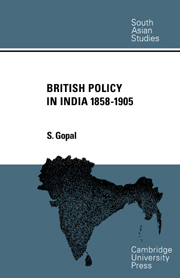Book contents
- Frontmatter
- Contents
- Preface
- Map 1 The Annexation of Burma
- Map 2 Afghanistan and Central Asia
- 1 The Aftermath of The Revolt, 1858–69
- 2 The Conservative Adventure, 1869–80
- 3 The Liberal Experiment—Ripon and Dufferin
- 4 Return to Caution, 1888–98
- 5 Curzon: The Apogee of Administration
- Conclusion
- Notes
- Bibliography
- Index
1 - The Aftermath of The Revolt, 1858–69
Published online by Cambridge University Press: 02 December 2009
- Frontmatter
- Contents
- Preface
- Map 1 The Annexation of Burma
- Map 2 Afghanistan and Central Asia
- 1 The Aftermath of The Revolt, 1858–69
- 2 The Conservative Adventure, 1869–80
- 3 The Liberal Experiment—Ripon and Dufferin
- 4 Return to Caution, 1888–98
- 5 Curzon: The Apogee of Administration
- Conclusion
- Notes
- Bibliography
- Index
Summary
Writing to his friend the Governor-General and Viceroy, Charles Canning, in India on 23 July 1859, Gladstone reported that the Cabinet had been informed the previous day ‘that that mutiny which may also be called rebellion, civil war, or whatever else is most formidable, was now really at an end’. It had in fact been much more than a mere mutiny. What had started as a rising of the Indian soldiers in the Bengal army gradually gathered support till it became the only large-scale revolt in India in the nineteenth century. The Indian sepoy (soldier) had some specific causes for discontent; but he was also in most cases only a peasant in uniform, and he could not but be affected by the general mood in the villages from which he came. Many of the soldiers of the Bengal army were Brahmins or Rajputs, and nearly a third of them had their homes in Oudh. They knew of the harsh and impatient manner in which the East India Company had set aside families which had been respected as royal for centuries. They were aware of the economic and social changes which were taking place in the country, of the land-holders who had been deprived and of the local industries which had been destroyed. They themselves had at times been marched in haste to stop such practices as the immolation of widows. So in 1857, when they mutinied, they incited as well as battened on sympathy from all the discontented.
- Type
- Chapter
- Information
- British Policy in India 1858-1905 , pp. 1 - 63Publisher: Cambridge University PressPrint publication year: 1965

